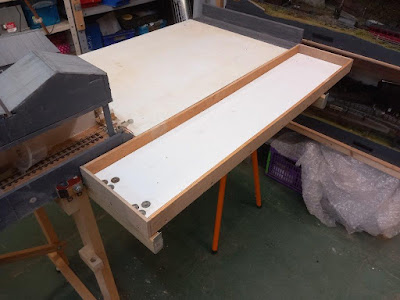'Show and tell'.
Fiddleyard storage shelf brackets.
Extra foliage.
Pipework.
Pigeons.
Yard clutter.
Both of us had 'homework' to display. Geoff had developed and made a new wagon for transporting large blocks of stone - a 3D printed, two-part chassis with additional timber detail. The Kadee couplings push neatly into the sockets.
 |
Stephen had added coloured track section markers to the control panel. Although newly purchased vinyl was used, the adhesive was not very strong, but it will be ok for the time being.
The main job of the day was to take a shelf support arm from a trestle and re-fix it to the new 4-leg framework. The shelf provides additional storage for cassettes adjacent to the fiddleyard. It normally comprises two hinged shelves, but only one could be fitted to the new frame, so a stop-end panel has been added.
More gutters and downpipes were added to the factory building.
And another to-do was completed - a bare patch of ground behind the engine shed received some foliage as well.
The yard clutter has been a thorny issue for some time, but agreement was reached at last. 3D printed pallets, stoneware items and an early forklift truck would be used to populate the area. Crates and loads will also be printed to carry the main products of paving slabs and architectural stone components.
Current stone wagon list and uses:
4/5 plank wagons will convey crushed stone direct from the quarry to the mainline interchange. The same wagons will convey waste stone from Edwards yard to the mainline.
2 plank versions of the 4/5 plank wagons (photo above) together with the new wagons will bring large slabs to Edwards yard.
4/5 plank wagons and vans will convey crated slabs and architectural stoneware from Edwards to the mainline.
Empties will return to the quarry and Edwards yard. Some movements will be with dedicated trains, but the addition of wagons to other trains 'en-route' is also anticipated, which should make for some interesting shunting!





















































